Journey of discovery across Shanxi
Updated: 2024-08-30
Teenagers from nine countries travel to province and learn about their ancestors
Shanxi is one of the cultural roots of Chinese people, wherever they are. That's what a group of teenage reporters learned when they finished a journey in the province.
A total of 29 teenagers from nine countries wrapped up a special study tour called the 2024 Shanxi Summer Camp for Young Reporters on Aug 9.The members reported what they saw in Shanxi in the form of livestreaming throughout their tour.
During the 12 days, the tour covered 10-plus reputed places of historical interest, including Jinci Temple in Taiyuan, Yungang Grottoes in Datong, and the ancient city of Pingyao in Jinzhong.
Experienced teachers from Shanxi were assigned to the summer camp, informing members of the history of the sites they visited, engaging them in cultural heritage protection activities and teaching them skills related to new-media reporting.
As all the camp members are from overseas Chinese communities, they showed a keen interest in tapping into the history and culture relating to their ancestral roots.
Cindy Liu from Canada said she had prepared herself for the trip by learning the history of Shanxi.
"I learned that Shanxi, with a history of more than 5,000 years, is one of the cradles of Chinese civilization,"Liu said. "And I was also informed that the long history has left a wealth of cultural assets here that have earned Shanxi the fame as one of China's top regions in terms of preserved cultural heritage items."
Liu brought with her a question that struck a chord among the camp members.
"Some overseas Chinese communities are usually known as Chinatowns to many," Liu said. "But we overseas Chinese like to call them tangrenjie – the towns of Tang people. So my question was what is the origin of this term."
"I guess in Shanxi I could find the answer to the question why our folks like to call ourselves Tang people," Liu said.
She visited Jinci Temple in Taiyuan, the capital city of Shanxi province. A teacher showed the camp members a stone stele in the temple, with inscriptions written by Li Shimin, one of the founding emperors of the powerful Tang Dynasty(618-907).
The teacher said that why overseas Chinese like to call their communities "towns of Tang people" has some associations with this dynasty that was founded by Li and his father.
"Tang was a powerful and prosperous dynasty in Chinese history, featuring a developed economy, flourishing culture and booming international exchanges," said the teacher.
"China has two powerful dynasties that people have taken pride in for thousands of years – the Han (206 BC-AD 220) and Tang," the teacher further explained.
The teacher said Shanxi was the source of Tang Dynasty because Li Shimin and his father Li Yuan were natives of Taiyuan and used to be military governors of the city. They used Shanxi as a base to unify the country and founded the Tang Dynasty.
But the teacher noted that the Tang Dynasty was not the first to use Tang as the name of their sovereignties.
"Jinci Temple is something closely related to the earliest Tang state,"said the teacher. "It is known to many that Jinci is an ancestral temple dedicated to Jin(1033-376 BC) – a vassal state in the Zhou Dynasty (c.11th century-256 BC) – and its founding monarch Shuyu.
"But I must tell you all that the Jin state was also called Tang and the full name of the founding monarch is Tang Shuyu," the teacher said. He added that the Jin state was where the recorded history of Shanxi began.
Legend has it that Ji Song became the second monarch of the Western Zhou Dynasty (c. 11th century-771 BC) when he was young. He once played with his younger brother, Shuyu, sending him a lump of soil as a gift.
The playful game was recorded by his ministers, who required the monarch to give his brother a certain territory as a fiefdom, appointing him the king of it because the soil represented the land of a state.
Ji honored his promise and Shuyu became the first king of the state that was called Tang – in the central part of today's Shanxi – at that time.
Shuyu made a great contribution to the development of the fiefdom, by leading locals to improve agriculture through building irrigation projects.
When Xiefu, the son of Shuyu, succeeded his father to become the second king, he changed the fiefdom's name to Jin. Xiefu built Jinci to memorialize his father.
The ancestral temple was renovated and expanded during the following millennia, becoming the largest ancient building complex in Taiyuan.
The quest of the spiritual roots of overseas Chinese was recorded on the cameras of the young reporters.
Kim Woo-jin from South Korea used his camera to record every detail of Jinci. He told his friends and audience about his discoveries of the ancestral temple complex in China.
"The temple has some oldest things in China," Kim said. "It is, for instance, the oldest ancestral temple and the oldest royal garden in China."
He targeted his camera to a huge cypress tree in the temple, saying that "this might be the oldest tree still alive in China".
He said there are two trees of the same age. "I was told that the two trees – one died in the early 1900s, only leaving its trunk – were planted by Shuyu himself and have a history of more than 2,900 years."
The teacher affirmed that the age of the trees is not a legend. "Carbon-14 dating proved that they are 2,600 to 2,990 years old," he said.
While tapping into the history of Shanxi, the camp members were offered an immersive experience of how the historical assets are protected and cultural heritage is inherited.
At a studio for heritage protection and inheritance in Jiexiu, Jinzhong city, the young camp members learned how to make stone rubbings.
Stone rubbings, also known as inkimprints, are one of the major inventions from ancient China. Using paper and ink, the engraved surfaces can be copied as images to depict history.
Under the instruction of the studio's teachers, the members used pieces of moistened paper to cover the surfaces of stone steles with inscriptions or carved images. They then used stiff brushes to press the paper tightly, bringing the images to light.
When the paper was almost dry, they used inked pads to tap or squeeze the surface, leaving the inked inscriptions or images on the paper. To their delight, when the paper was peeled off, they saw impressions of the engraved texts or pictures emerge clearly on the paper.
A teacher said this traditional technique is an important skill for preserving and passing down Chinese cultural heritage.
"The stone rubbing works contain loads of information about history, culture, art and life in ancient China,"the teacher said."They are not only the copied images of cultural relics but also the carrier of history and precious memories from China's past."
At Yungang Grottoes Academy, an institution engaged in the operation of the famed Yungang Grottoes in Datong, the camp members were taught by professionals on how to repair and preserve historical relics.
At the academy, the members learned that preserving a historical and cultural heritage site that was created more than 1,500 years ago would be a challenge in any country. But Yungang Grottoes fulfilled the task thanks to the efforts of researchers and professionals in recent decades.
Yungang Grottoes was built during the Northern Wei Dynasty(386-534).The grottoes were carved out of sandstone cliffs at Wuzhou Mountain in the northwestern suburbs of Datong.
A total of 54 main caves were carved out during the period from 460-524. Today, 45 main caves remain intact, which house more than 59,000 statues, ranging from a few centimeters to 17 meters in height.
Yungang Grottoes was added to the UNESCO World Cultural Heritage List in 2001.
While proud of its increasing recognition in the world, local researchers understand that, after Yungang Grottoes having been battered by wind and rain for over 1,500 years, protecting this cultural heritage site has become a pressing challenge.
Initial preservation work on the grottoes started in the 1930s and systematic protection has been made since the founding of the People's Republic of China in 1949.
Efforts in protection have been enhanced since the establishment of Yungang Grottoes Academy in February 2021.
An expert at the academy, who was teaching the camp members about relics repair and protection, said that the main target is to maintain the authenticity of the relics and the grottoes as a whole. For this purpose, he added that a scientific and systematic approach, which combines both traditional skills and modern techniques, should be employed.
"We are teaching you some fundamentals on repair," the expert said."But I want to tell you that repairing relics requires long-term concentration, as work on some sections of relics can take several years to finish."
The camp members made their attempts on some replica wall paintings. During that process, Piao Zhiyan from South Korea was careful about everything, although he didn't expect an immediate success.
"This was the first time I tried my hands on relics repair," Piao said."It was a mission impossible for me this time, but it gave me a clear idea on the importance, difficulty and imperativeness of heritage protection."
Alicia Jiang and Jin Jiayi from Spain also showed a keen interest in relics repair."Compared with seeing the exhibits and hearing the stories of relics, engaging yourselves in relics repair will help you better understand the value of cultural heritage,"Jiang said.
In many locales in Shanxi, the camp members had the opportunity to make cultural heritage items, like wood carvings and pottery.
Learning to improve their livestreaming and video-making skills was another important task for the camp members. There were dedicated teachers to help them in videomaking procedures, like interviews, shooting and post production.
Liew Li Han from Malaysia said the improvements he made are always in the details. When hosting a short video featuring a Shanxi merchant residence in Jinzhong, he was confused by the pronunciation of Shanxi and Shaanxi.
"This is the Qiao Family Courtyard in Jinzhong, Shaanxi ... oh sorry, Shanxi province," he said to the camera. A teacher told him that the pronunciation differs with the accent and he immediately found the right way.
Guo Yanbin, an official from the United Front Work Department of the Shanxi Committee of the Communist Party of China, had been with the young camp members during their journey. He said he felt the growth of the youngsters during the 12 days in terms of livestreaming and video making.
"The video productions of the camp members show the unique traits of vigor, curiosity, innovation and originality," Guo said."They have presented vivid stories of Shanxi with their own points of view."
The summer camp was sponsored by the Chinese Language and Culture Education Foundation of China, an organization promoting Chinese language and cultural education overseas.
Under the arrangement of the organization, four Chinese-language schools from Germany, the Netherlands, Pakistan and Myanmar signed agreements with two schools in Taiyuan on Aug 8, aiming for enhanced curriculum and teaching methodology cooperation.
SCS Delft, a Chinese-language school in Delft, the Netherlands, is among the schools to have signed up.
Liu Yan, an SCS Delft teacher, said he expects the cooperation program to help with the sharing of resources between China's and overseas schools through more frequent online and offline exchanges.
Hao Hong contributed to this story.
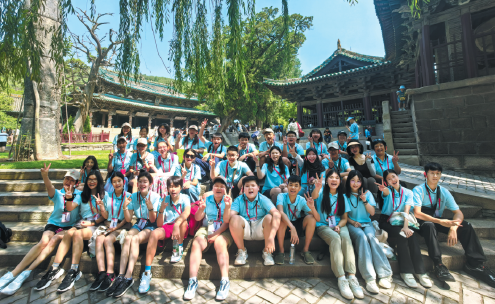
Members of the summer camp pose for a photo at Jinci Temple. HAO SHENGYU/FOR CHINA DAILY
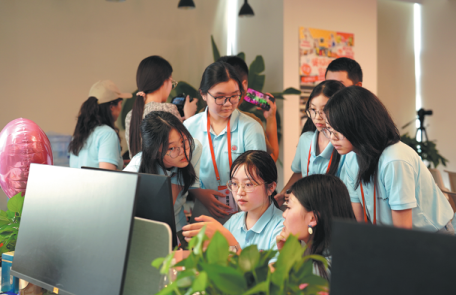
Camp members attend a class on video post production. Provided to CHINA DAILY
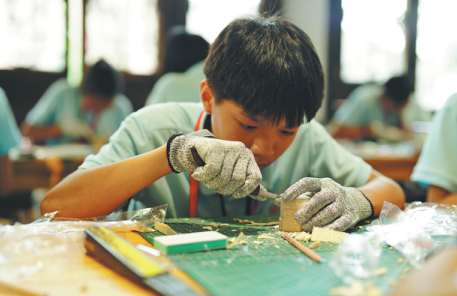
Students learn to make wood carvings at a studio in Jiexiu. Provided to CHINA DAILY
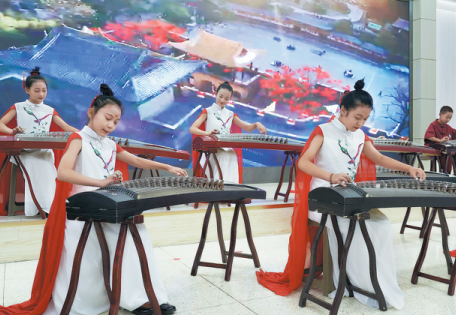
Local students perform the traditional musical instrument of zheng at the closing ceremony of the summer camp. LI YAO/FOR CHINA DAILY
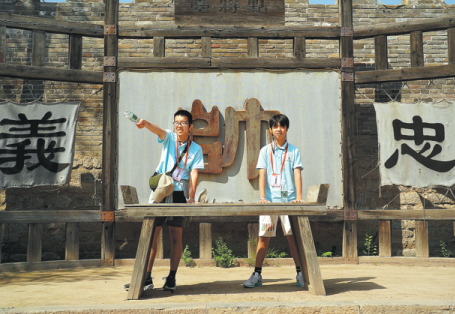
Two camp members host a livestream at an ancient castle in Jiexiu city. LI YAO/FOR CHINA DAILY
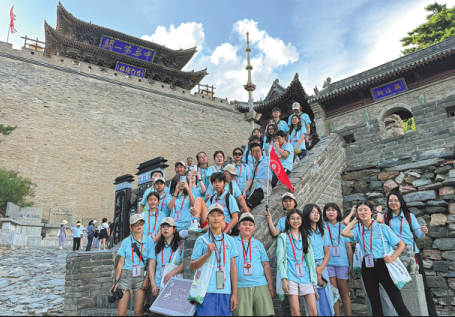
Camp members visit the Great Wall fortress of Yanmen Pass in Xinzhou. FENG SIQUAN/FOR CHINA DAILY




